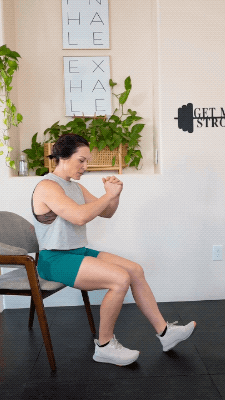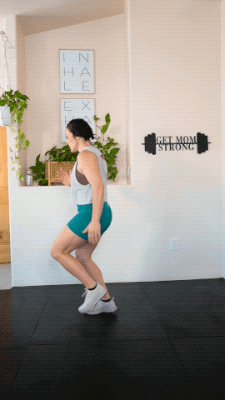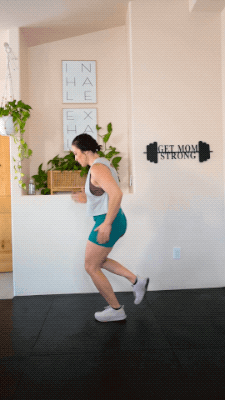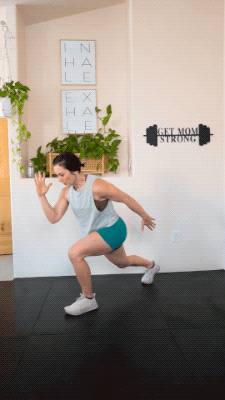How long do you have to wait before you can start running postpartum?
The truth is, every woman and her postpartum recovery is different. Some women can begin running after 12 weeks, but for others, it may be many months postpartum.
Risks of Running Too Soon After Birth
It is important to wait at least 12 weeks after giving birth to begin running. While you might be eager to lose the baby weight, running too soon can set you back long-term.
- Your body went through very real physical trauma during pregnancy and birth. (Even if you had a C-section!)
- Your ligaments are looser due to pregnancy and postpartum hormonal changes.
- Your core needs to be rebuilt after all the stretching and shifting it did as you GREW A BABY.
- The weight of the baby shifted how you carried your weight. This often results in weaker glutes, especially in the gluteus medius (side butt).
- More than 2 out of 3 postpartum women deal with pelvic floor dysfunction. Symptoms include: abdominal separation, musculoskeletal pain, leaking and incontinence and pelvic organ prolapse.
Running too soon can result in longer term pelvic floor problems. Running before your body is ready may increase your likelihood of pelvic organ prolapse and incontinence.
Wait 12 weeks, at least, to let your body heal. Listen to your body. Work on breathing and slowly incorporate walking and gentle, low impact exercises. It’s best to focus on exercises that support core and glute healing and strengthening.
How to Get Back to Running Postpartum
A group of pelvic health therapists developed a set of guidelines to help women return to running safely. The goal of this report is to educate doctors and runners about returning to the sport. Each person should adapt it to their individual needs.
Running is a very high-impact activity. Your legs need to absorb impact AND stabilize your body as you transfer weight from one foot to the other. Also, your pelvic floor has to be able to absorb the impact with each stride.
7 Exercises to Help You Return to Running Postpartum
To check if you’re ready to run postpartum, you should be able to do the following without pain, pressure, or leaking:
1. Walking
Walk for 30 minutes without any pain or heaviness in your vagina. Pay special attention to your core and pelvic floor, but also make sure there’s no pain in your glutes, legs, and so on.
2. Single Leg Balance
Hold a single leg balance for at least 10 seconds (both sides).

3. Single Leg Squat
Go from sitting in a chair to standing using a single leg 10 times (both sides).

4. Jog In Place
Jog in place without any leaking or heaviness for one minute.

5. Forward Bounds
Leap forward, landing on one foot, alternating legs, 10 times.

6. Hop In Place
Hop in place for 10 repetitions on each leg.

7. Single-Leg “Running Man”
Stand on one foot, reach out your opposite arm and leg (knee bent), 10 times on each side.
Once you feel confident with these exercises, start by trying a walk/run combination. This is a great way to recondition your body and help ease you into that first run after giving birth.
How Running Form Affects Your Pelvic Floor Postpartum
Most of us aren’t going to be able to jump right back to running as we did pre-baby. Thanks to all the changes resulting from growing and birthing a baby, it’s imperative to also look at your form. Taking some time to “get back to the basics” is going to help you out long-term.
Common Postpartum Running Mistakes
Here are some common mistakes when it comes to running form (and how to fix them):
· Don’t: Run with a flat-footed heel strike. This forces the pelvic floor to absorb a very hard shock. It can weaken the pelvic floor muscles.
· Do: Land on the ball of your foot. Aim for a gliding, soft landing motion.
· Don’t: Run upright without using your glutes. Your chest puffs out, and ribs flare. This can also lead to leaking/incontinence, overusing your thighs and underusing your hamstrings.
· Do: Check your posture, especially if you leak while running. Lean forward slightly to drive with your glutes and activate your pelvic floor.
· Don’t: ONLY run. Running is done on the sagittal plane, AKA a forward and backward motion. Without incorporating different forms of exercise, you’ll likely end up with imbalances, poor thoracic rotation or other injuries. Poor thoracic mobility can affect the shoulder, neck, low back, and hip.
· Do: Add in strength training. Specifically, work on lateral, or side to side, movements. My SLAM program incorporates tons of movements using all planes of motion.
One of the best ways to improve running posture postpartum is to run uphill. Practice running up a hill and then walking back down. This will help activate the front of your pelvic floor and cue glute activation.
Can You Run with Diastasis Recti?
The good news is there is no evidence that you can’t, or that it’s bad to run with diastasis recti. Experts agree that running before 12 weeks postpartum may exacerbate symptoms, since your body is still healing. But once you’ve reached 12 weeks, you can begin running if your diastasis is functional.
A functional diastasis recti means there’s still a gap, but you can manage pressure and move without doming or sinking in your midline.
Can You Run with Prolapse?
It depends on the severity of your prolapse after childbirth. If your doctor or pelvic floor physical therapist diagnosed you with a grade 3 or 4 prolapse, you’ll want to avoid running or jumping for now.
If you have a milder case, it is okay to run with a few considerations.
You’ll want to ensure that your running form is good. Think about leaning forward slightly and driving with your glutes.
Be sure you’ve done the prep work mentioned above. You need to be sure you have strong hips and calves, and good balance.
Lastly, use a pessary if needed. A pessary can add internal support, helping reduce prolapse symptoms when running.
Can You Run with Incontinence?
If you are dealing with incontinence while running, it can be because your pelvic floor is weak or too tight. Either way, it is a sign your body isn’t managing core pressure while running well. Improved posture, glute strength and pelvic floor release work can improve incontinence while running.
Need Help Returning to Running Postpartum?
The Strong Like A Mother (SLAM) program helps you build total body strength, while healing your core and pelvic floor. You don’t have to settle for postpartum side-effects. Let’s get you back to running and more!

